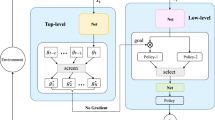Abstract
HEXQ is a reinforcement learning algorithm that decomposes a problem into subtasks and constructs a hierarchy using state variables. The maximum number of levels is constrained by the number of variables representing a state. In HEXQ, values learned for a subtask can be reused in different contexts if the subtasks are identical. If not, values for non-identical subtasks need to be trained separately. This paper introduces a method that tackles these two restrictions. Experimental results show that this method can save the training time dramatically.
Preview
Unable to display preview. Download preview PDF.
Similar content being viewed by others
References
Sutton, R.S., Barto, A.G.: Reinforcement Learning: An Introduction. MIT Press, Cambridge (1998)
Dayan, P., Hinton, G.E.: Feudal reinforcement learning. In: Hanson, S.J., et al. (eds.) Advances in Neural Information Processing Systems, vol. 5, pp. 271–278. Morgan Kaufmann, San Mateo (1993)
Singh, S.P.: Reinforcement learning with a hierarchy of abstract models. In: Proceedings of the Tenth National Conference on Artificial Intelligence, San Jose, CA, USA (1992)
Hengst, B.: Discovering Hierarchy in Reinforcement Learning with HEXQ. In: Maching Learning: Proceedings of the Nineteenth International Conference on Machine Learning 2002 (2003)
Kernighan, B.W., Lin, C.: An Efficient Heuristic Procedure for Partitioning Graphs. Bell Systems Technology J. 49(2), 292–370 (1970)
Hochbaum, D.S., Pathria, A.: The bottleneck graph partition problem. Networks 28(4), 221–225 (1996)
Dutt, S.: New Faster Kernighan-Lin-Type Graph-Partitioning Algorithms. In: ICCAD 1993: Proceedings of the 1993 IEEE/ACM international conference on Computer-aided design, Santa Clara, California, United States (1993)
Author information
Authors and Affiliations
Editor information
Editors and Affiliations
Rights and permissions
Copyright information
© 2005 Springer-Verlag Berlin Heidelberg
About this paper
Cite this paper
Poulton, G., Guo, Y., Lu, W. (2005). Finding Hidden Hierarchy in Reinforcement Learning. In: Khosla, R., Howlett, R.J., Jain, L.C. (eds) Knowledge-Based Intelligent Information and Engineering Systems. KES 2005. Lecture Notes in Computer Science(), vol 3683. Springer, Berlin, Heidelberg. https://doi.org/10.1007/11553939_79
Download citation
DOI: https://doi.org/10.1007/11553939_79
Publisher Name: Springer, Berlin, Heidelberg
Print ISBN: 978-3-540-28896-1
Online ISBN: 978-3-540-31990-0
eBook Packages: Computer ScienceComputer Science (R0)




